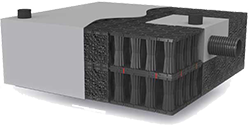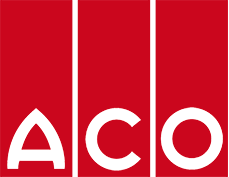Maintenance and Inspection Guidelines for ACO StormBrixx
Even the best-designed stormwater systems are vulnerable to failure without proper maintenance and inspection. Sediment build-up inside a retention tank or an infiltration tank can dramatically reduce performance, risking flooding, costly repairs and costly repairs.
This guide outlines practical procedures to help you extend system life, uphold design capacity and keep your ACO StormBrixx® installations operating at their best.
 Maintenance procedures
Maintenance procedures
It is important to note that failure to control and remove sediment build-up in stormwater tanks is the largest cause of system failure.
The open design of ACO StormBrixx® allows the system to be inspected by remote CCTV either through the inlet connection, access chambers, inspection points or pipes at the sides of the ACO StormBrixx® system. This allows the system to be inspected for sediment build-up and enables collected sediment to be removed from the infiltration system or flushed through a retention/detention system.
As sediment has the potential to carry high levels of pollutant, it is important that any sediment removed from the system is disposed of by a licensed contractor and in accordance with local regulations and codes.
 In order to periodically check the effectiveness of the StormBrixx® infiltration system, a percolation test can be carried out on the tank and compared with the original data. If there is a significant decrease in the infiltration rates, the infiltration tank should be filled via the inspection chamber to the invert level of the inlet pipe.
In order to periodically check the effectiveness of the StormBrixx® infiltration system, a percolation test can be carried out on the tank and compared with the original data. If there is a significant decrease in the infiltration rates, the infiltration tank should be filled via the inspection chamber to the invert level of the inlet pipe.
It should then be flushed through with water in order to remove sediment and unblock the geotextile.
In order to clean the ACO StormBrixx® system, it will be necessary to block the outflow control device, not the overflow pipe, before filling the tank to the invert of the vent pipe. The tank should be filled and flushed, and the water effluent removed and disposed of by a suction truck with vacuum pump.
 The frequency of a maintenance procedure for the tank will be determined by the inspection regime. A recommendation is not less than twice-yearly inspections and during the first year after every significant storm event.
The frequency of a maintenance procedure for the tank will be determined by the inspection regime. A recommendation is not less than twice-yearly inspections and during the first year after every significant storm event.
In order to minimise silt build-up, ACO recommends the use of pretreatment systems upstream of the retention/detention system.
The importance of pretreatment for retention and infiltration tanks
Before water reaches a retention tank or infiltration tank, upstream pretreatment removes debris, oils and coarse sediments that can block or damage the system. Common solutions include gross pollutant traps, sedimentation pits, filter units and first flush devices. The right pretreatment solution varies based on site-specific risks such as the nature of anticipated traffic or function or purpose of the site itself.
Effective pretreatment not only protects the tank’s storage capacity, but also improves infiltration rates and reduces the need for early maintenance. It also helps systems cope better during peak storm events and supports long-term compliance with stormwater management standards.
Effortless maintenance starts with exceptional hardware
ACO has been a pioneer in drainage and stormwater management for decades. As a family-owned company with a global footprint and a strong local expertise, we understand the unique demands of Australian projects. Our ACO StormBrixx® systems are built for durability, flexibility and long-term performance — with tailored support available from design to installation.
Browse our full range of stormwater solutions, or reach out to our technical team for tailored advice or product selection support. You may also browse our site for comprehensive guides on installation and assembly.






